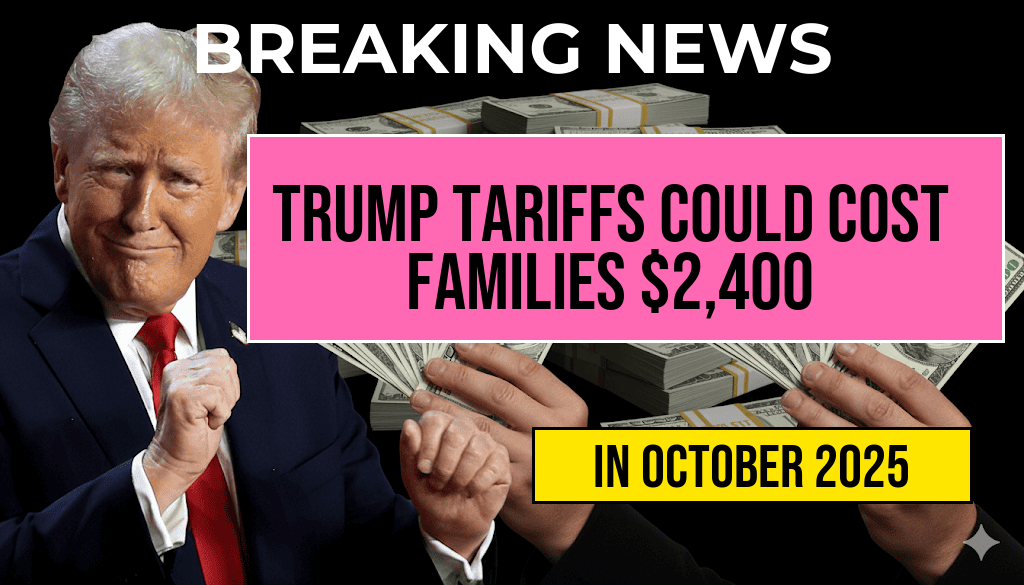Recent discussions surrounding potential tariffs proposed by former President Donald Trump suggest that American families could face an average annual increase of approximately $2,400 in household expenses. Dubbed the “Turbulence Tax” by critics, this hypothetical economic measure aims to impose tariffs on various imported goods, potentially escalating costs across multiple sectors, from consumer electronics to groceries. While the specifics of such tariffs remain uncertain, economic analysts warn that the ripple effects could significantly strain household budgets, especially for middle- and lower-income families. This article breaks down how these tariffs could impact everyday Americans, what sectors are most vulnerable, and the broader implications for the U.S. economy.
Understanding the Proposed Tariffs and the “Turbulence Tax”
The concept behind the so-called “Turbulence Tax” revolves around implementing new tariffs on imported goods, ostensibly to bolster domestic manufacturing and reduce trade deficits. However, critics argue that these tariffs could lead to higher prices for consumers, as importers pass along increased costs. The potential tariffs target a broad range of products, including electronics, apparel, and food items, which form the backbone of many household budgets.
While the actual policy details remain fluid, economic models suggest that even moderate tariffs could have a cumulative effect, raising the average household’s annual expenses significantly. The term “Turbulence Tax” has emerged in media circles to describe the economic dislocation and cost increases associated with these trade policies, emphasizing the turbulence it could introduce into household finances.
Estimating the Cost Impact on American Families
Methodology of the Cost Breakdown
Economists estimate that a combination of tariffs on key imports could add roughly $200 to $300 annually per household, with the total reaching approximately $2,400 if tariffs are widespread and sustained. These projections consider the increase in retail prices across various sectors, as well as the ripple effects on supply chains and consumer goods pricing.
The analysis incorporates data from the U.S. Bureau of Labor Statistics and recent trade tariff proposals, modeling how increased costs for imported goods translate into higher retail prices. It also considers the potential for retaliatory tariffs from trading partners, which could further inflate costs.
Key Sectors Affected by the Tariffs
| Sector | Potential Cost Increase | Examples of Affected Items |
|---|---|---|
| Electronics | 15-25% | Smartphones, laptops, gaming devices |
| Apparel and Footwear | 10-20% | Clothing, shoes, accessories |
| Food and Beverages | 5-15% | Imported fruits, snacks, beverages |
| Home Goods | 8-18% | Furniture, kitchenware, decor |
Broader Economic Implications
The potential tariffs could have complex effects beyond direct consumer costs. Manufacturers relying on imported components might face increased production costs, potentially leading to job cuts or reduced wages. Conversely, proponents argue that tariffs could protect domestic industries and create new jobs in manufacturing sectors. However, economic studies indicate that the net effect often favors higher consumer prices and reduced purchasing power, especially if tariffs provoke retaliatory measures from trading partners.
Trade experts warn that sustained tariffs might also contribute to inflationary pressures, complicate supply chain logistics, and dampen economic growth. According to data from [Forbes](https://www.forbes.com) and [Wikipedia](https://en.wikipedia.org/wiki/Trade_war), trade conflicts historically correlate with increased consumer prices and economic uncertainty.
What Consumers Can Expect
Based on current projections, households could see their grocery bills, electronics purchases, and apparel expenses rise notably. For example, a family with a typical annual spending of $20,000 on goods vulnerable to tariffs might face an additional $2,400 annually—equivalent to roughly $200 per month. This increase could strain budgets, especially for families already operating near financial margins.
Experts recommend that consumers monitor ongoing trade negotiations and consider adjusting spending habits accordingly. Small adjustments, such as seeking locally produced alternatives or timing major purchases, might mitigate some of the cost impacts.
Sources and Further Reading
Frequently Asked Questions
What is the “Turbulence Tax” and how does it affect families?
The “Turbulence Tax” refers to the increased costs imposed by Trump tariffs on imported goods, which can lead to higher prices for everyday products. This means families could face an additional $2,400 annually in expenses due to these tariffs.
How do tariffs impact the prices of household goods?
Tariffs on imported goods often lead to increased costs for manufacturers and retailers. These costs are typically passed down to consumers, resulting in higher prices for clothing, electronics, appliances, and other household items.
Which families are most affected by the “Turbulence Tax”?
Families with lower to middle incomes are most impacted, as they tend to spend a larger portion of their income on imported goods. The additional $2,400 annual cost can significantly strain household budgets.
Are there specific products that will see the biggest price increases due to tariffs?
Yes, products such as consumer electronics, clothing, furniture, and certain food items are more likely to experience notable price hikes because they are heavily imported and affected by tariffs.
What can families do to mitigate the financial impact of the “Turbulence Tax”?
Families can consider buying domestically produced goods, reducing discretionary spending, or exploring alternative shopping options to minimize the effect of higher prices caused by tariffs and the resulting “Turbulence Tax”.

Leave a Reply